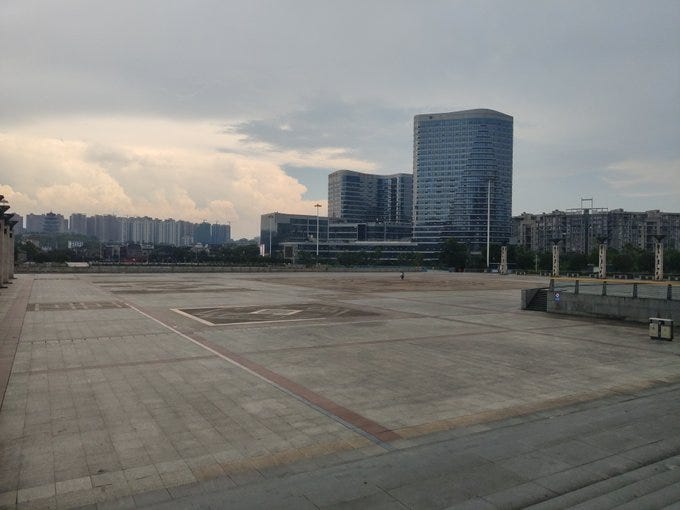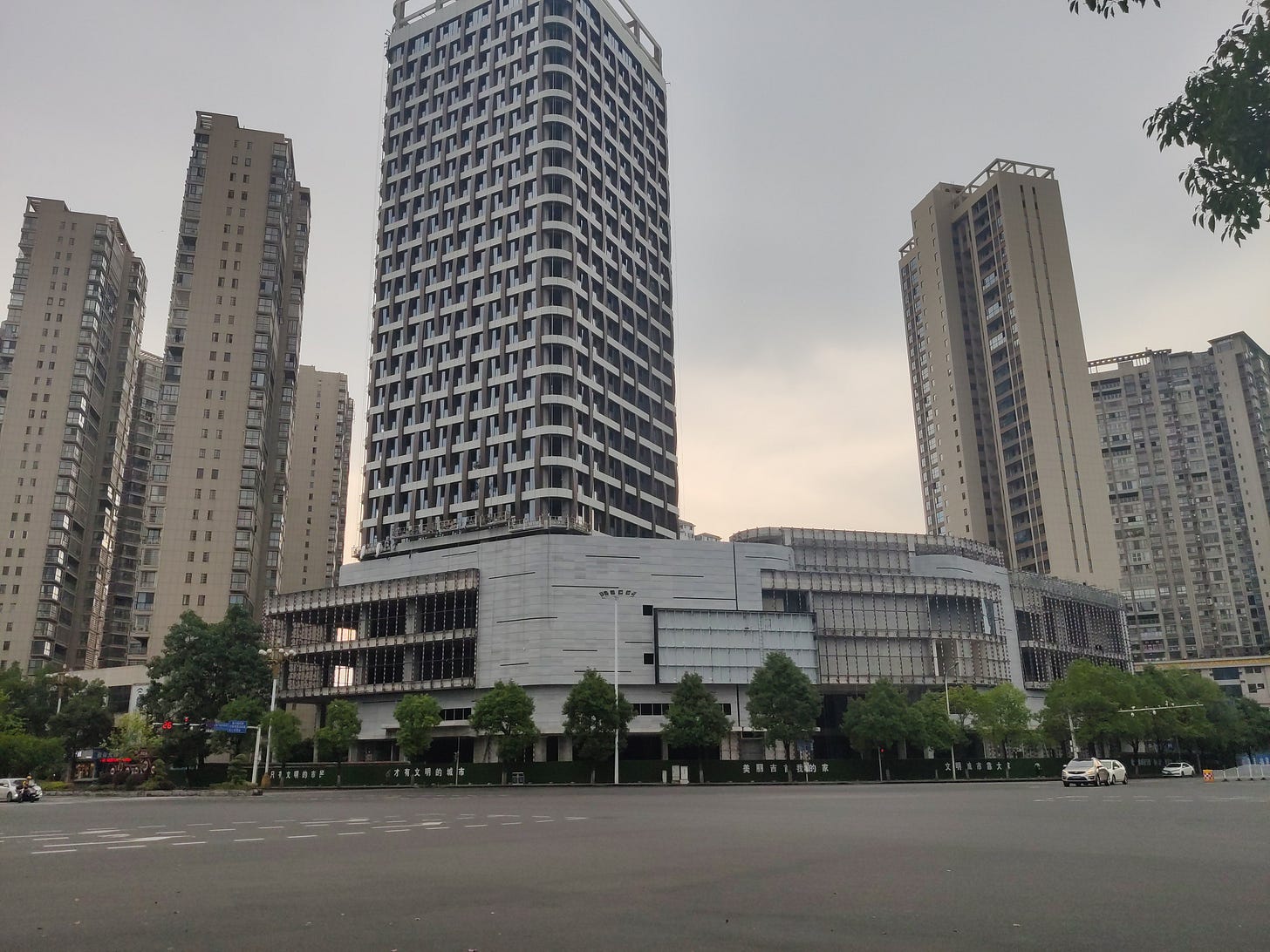Western Hunan and Jishou City - Central Planning at Work
What makes a Chinese city qualify as a "ghost city?"
This thread was originally posted to Twitter on July 5, 2022. It is reposted here in long-essay format with minor revisions and wording tweaks. Video links have been removed, as Substack has not yet allowed me to join their video beta.
After leaving Chenzhou, we made our way to Jishou 吉首, in western Hunan. Jishou is a good jumping-off point for travel to attractions like Fenghuang Ancient City, Dehang Canyon, Furong Village, etc. Jishou itself is...very empty.
Background: Jishou is different from other cities I've visited so far in Hunan. Jishou is the capital of the Xiangxi Tujia and Miao Autonomous Prefecture. Xiangxi is the name of the Autonomous prefecture, and Tujia and Miao are different ethnic minorities that make up the majority of the population here. Autonomous prefectures are on the same level as prefecture-level cities in China, underneath provinces. Xiangxi 湘西 literally means "West Hunan" and that's where it is located
This means Jishou doesn't really match up with a prefecture-level 地级市 OR a county-level city 县级市. It's its own thing, a "Region capital" 州首府. Jishou's official census population is just over 400k people, which is roughly comparable to a county-level city (recall that Zixing City in Chenzhou had about 320k).
Here's the thing: Jishou has not been designed to be a city with 400k people. It feels like a city that has been designed for 5+ million people. It's got about the population of Zixing but has infrastructure that wouldn't look out of place in a provincial capital. And it is still building more! The area directly in front of the massive city government building is called Century Plaza and it was totally deserted both times I came, first in the evening and again around noon. I spotted an 8-lane avenue merging into a 6-lane avenue being used by no more than 15 cars. What’s going on here?
After talking to locals, I discovered:
Land is very cheap here, so everything is constructed bigger and is still very cheap. I saw new apartments being advertised at the incredibly low price of 3,668 RMB/sqm (about half of what we saw in Chenzhou and about 1/50th the price of a Shanghai apartment).
Where I am right now is actually the “new district” of Jishou, a top-down planned expansion to the city. The city government recently moved over here, and they are still building the rest of the area, with plazas, hotels, malls and other public infrastructure planned, but right now it’s still too far from where most people in Jishou live, in the old city center 10km away, so few citizens of Jishou have much of a reason to come here yet.
A taxi driver told me all the bureaucrats working in the new city gov't here have to commute to work from the residential district to the north. They have no choice because their workplace has already been moved down here. But until these under-construction malls and office buildings are completed an more “regular” jobs appear, the area will probably be underpopulated overall.
Next to Century Plaza, I find a sign for a new mall that is opening here soon, promising to bring Starbucks, Nike, Xiaomi and many other brands, and all the associated jobs working in the mall. Outside, they are helpfully advertising the hiring salaries of every store in the mall. Most retail & F&B jobs hiring at 3-6k RMB per month. That salary level should be high for this region I think, especially since these kinds of jobs in China usually include room and board.
A few streets away from the empty central plaza area, I do find some normal-looking neighborhoods, with residents, shops, and traffic. Jishou is clearly different from the other kind of “ghost cities” that are often discussed in China: the huge empty housing estates on the edges of lower-tier cities, like what I saw in Chenzhou. This part of Jishou feels like a real TOWN that had the infrastructure for a proper CITY copy-pasted on top of it. [I had a video but can’t post it on Substack.]
And of course, like any good city, Jishou needs its own local attractions, so some of those have been created as well. Near the empty central plaza, I find a tourist attraction called Qianzhou Ancient City. It looks like it was built on/around what was once a real, old village, but now most of the construction here is new.
I take a stroll around, but almost everything is closed. It feels like I sneaked into an amusement park a week before it opened.
If you’re a fan of city builder games, it feels like they’re playing real-life Cities:Skylines here (or SimCity for the older generation).
In those games, when you want to populate a new area, you zone it out, “seed” it with schools, parks, fire stations, tourist attractions, etc., then wait for the residents and commercial businesses to move in.
And that's just it - these urban developments are created with the same logic of a omnipotent player in a city sim video game: If you build it, they will come. They look empty at the start, because they are, until they aren't. Just like what people said about Shanghai’s Pudong New District at first...or Ordos City in Inner Mongolia…or many other planned cities in China.
Unfortunately, our media rarely, if ever, revisit these stories after they reported as “ghost cities” initially, leaving the impression in readers’ minds that these Chinese cities are still empty, eerie, and uninhabited YEARS after they have actually filled up. If they ever revisit the topic, it’s not to look for signs of change, but to reiterate that nothing has changed, without giving any time for things to improve, or sometimes with even making any effort to confirm whether it’s still true. The Bloomberg piece I linked above about Ordos City is a rare, rare exception. Once Bloomberg reported it, however, other media outlets jumped on-board to follow the trend of announcing that Ordos was no longer a ghost city.
So then…where will Jishou be in 5-10 years? Well, with jobs created there, its role as the capital, and affordable real estate, I wouldn't be surprised if its population will have doubled or even more, filling up the city over time just like the other "ghost cities", as has been noted by others. Here’s a screenshot of text from Wikipedia reflecting the thoughts of journalist and author Wade Shepard, the guy credited with actually coining the term “ghost cities”.
Thus, I think this new district of Jishou is really quite different from the other kind of "ghost city" in China, those vast plots of cheaply-made McMansions or high-rises on the distant peripheries of cities like what I saw in Chenzhou, which never had a real shot at being functional neighborhoods, but instead were only treated as investment properties for people who thought the real estate sector could only go up, up, up. If you try that in Cities:Skylines, no one will move in either. This speculative overbuilding is a real phenomenon that continues to this day and is not the product of centralized planning I think, but rather a lack of centralized planning…leaving the investment and construction decisions up to real estate developers and local governments.
Unfortunately, I think this a distinction, among many, that is often missed by China's fans and detractors both, in academia or media. It's possible for China to have BOTH big-brained, centrally-planned, optimally-designed, mixed-use urban developments AND wasteful vanity/GDP bloat projects. It's a big country, after all. How could they ALL be failures, or ALL be excellent planning choices?
But then again, this is social media, where people often barely read six words before making up their mind, and where years-old footage can be recycled ad nauseum by lazy commentators for impressionable audiences that simply don’t have access to the information themselves. On that point, I hope sharing my experience in Jishou can serve some very small purpose in improving that.










